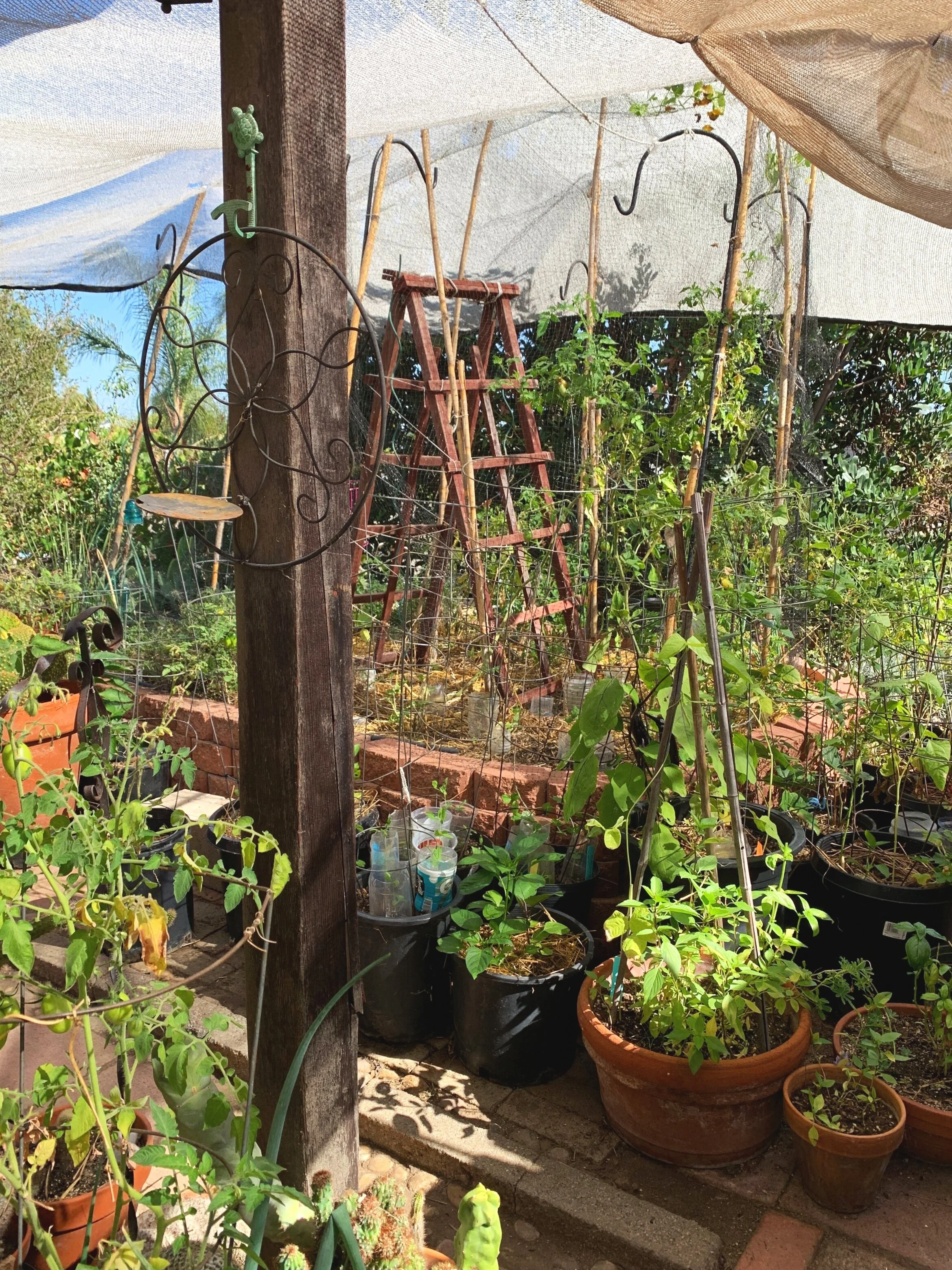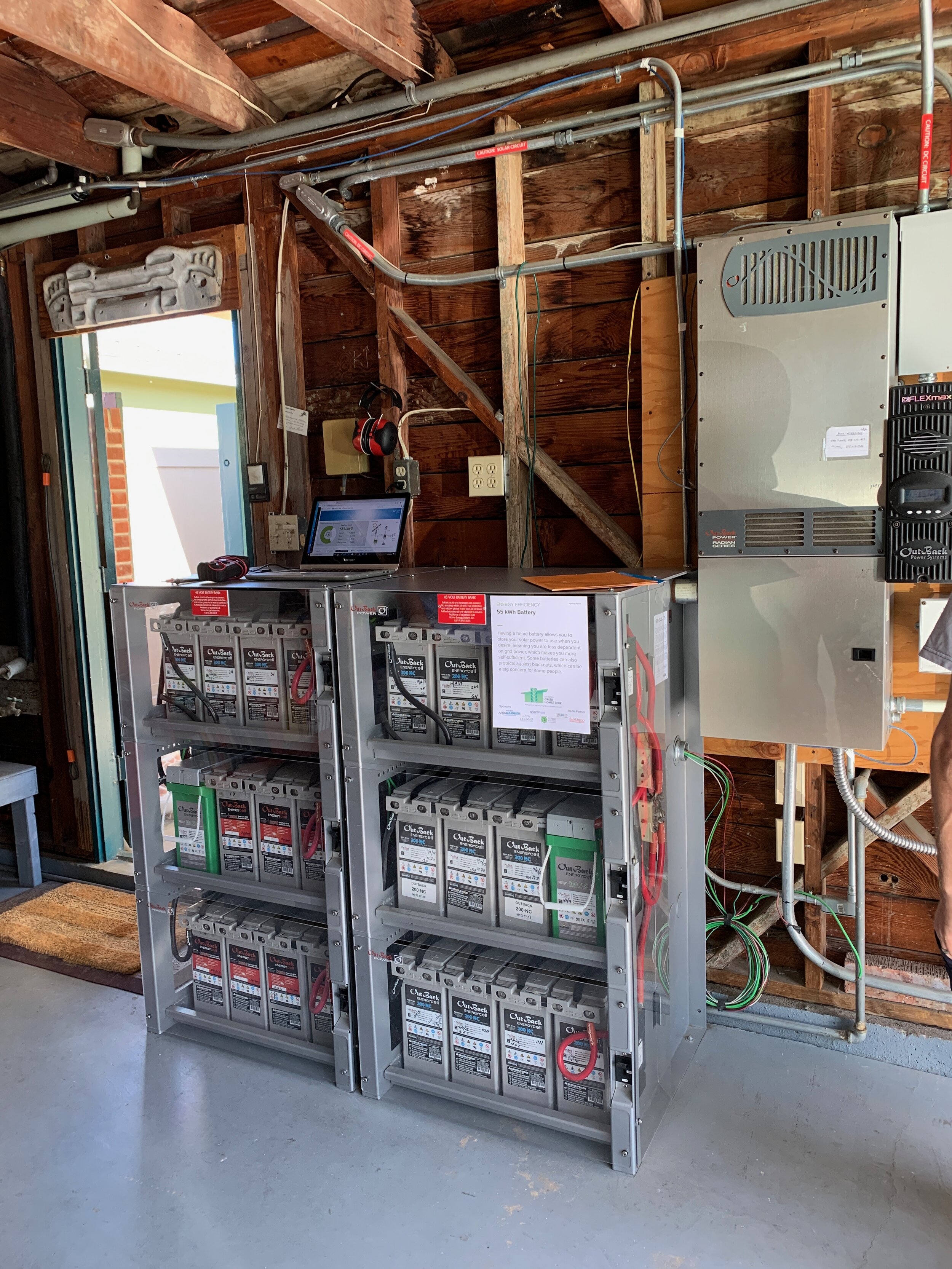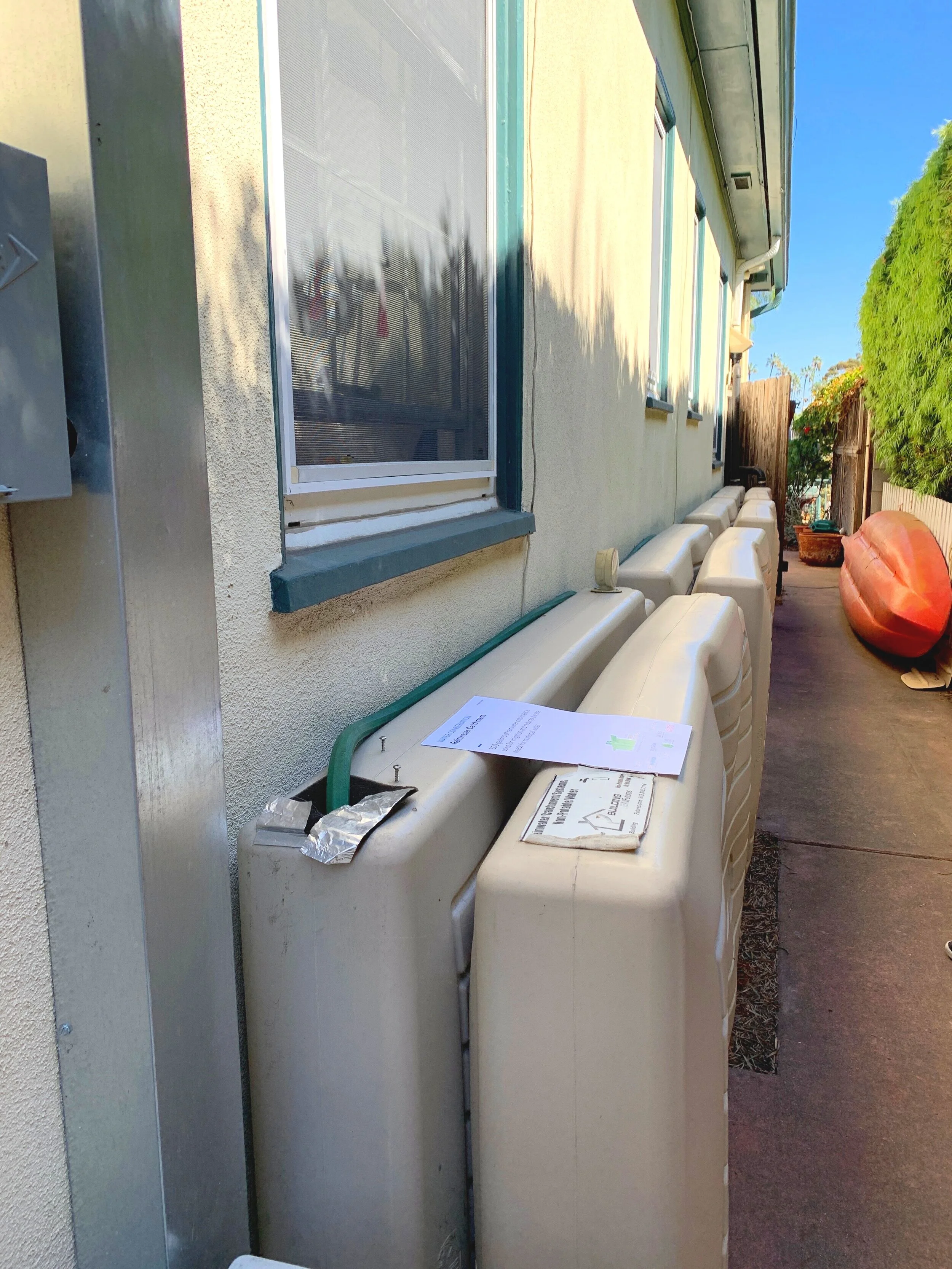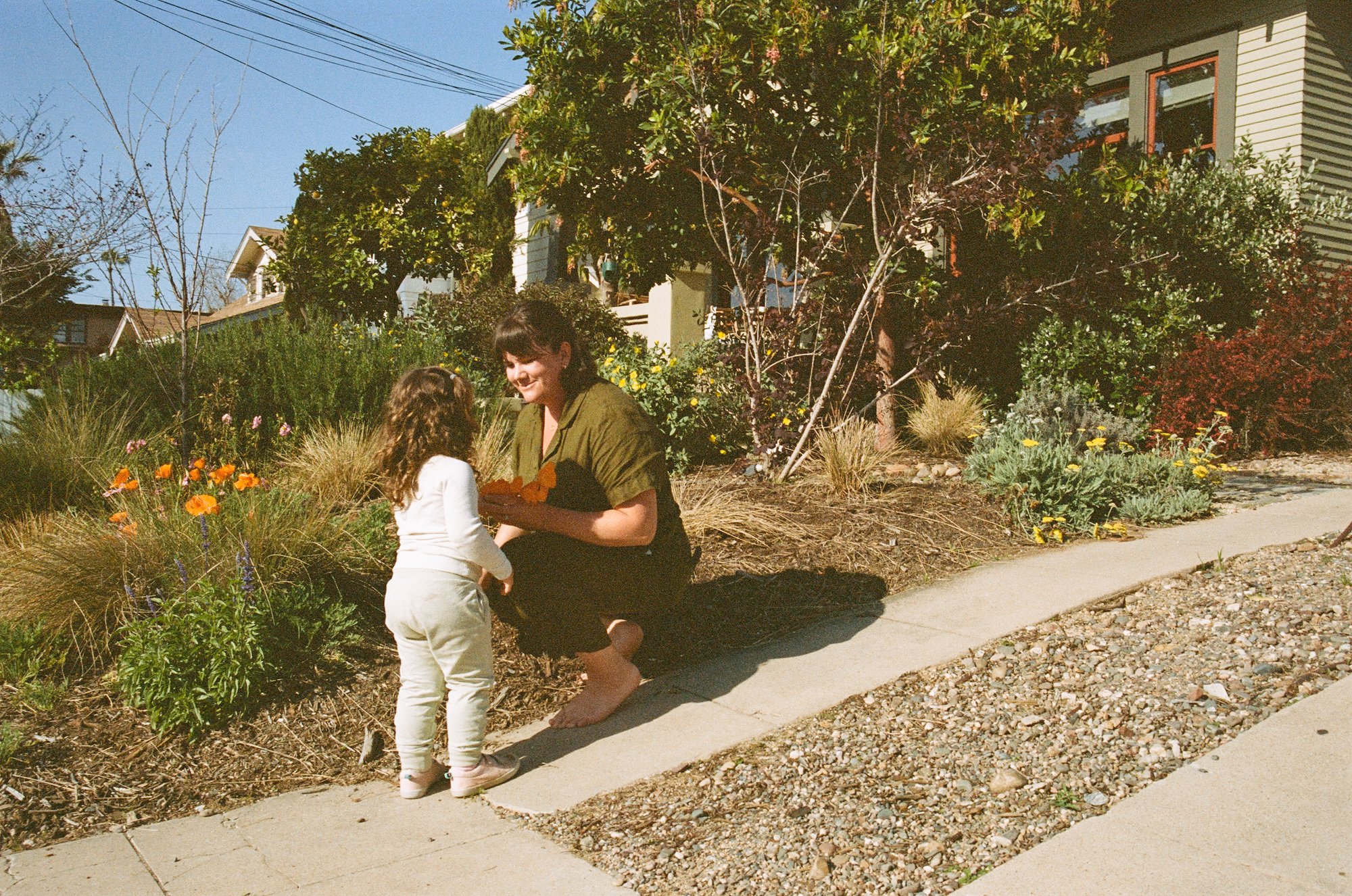My Takeaways from the Green Homes Tour - Both Good and Bad
/I went on the San Diego Green Homes Tour this weekend, which is a two-day ticketed event that allows folks to explore “green” homes all over the San Diego region. The goal is to spread awareness about environmentally friendly design to homeowners, designers, or just curious humans - it was open to all. The houses range from being showy multi-million dollar new constructions in beach-front communities, to small semi-homesteads with modest DIY improvements.
I went on the tour last year, and wrote a little about it and summed up many of the recurring green home improvement practices that were demonstrated during the tour. You can take a look at that here, but know that my knowledge of home improvement and sustainability has grown in the last year, so I’m going to do an updated post with more info soon. For now, I want to share some of my thoughts on why I need to update that post, and address some of what I saw on the tour.
First, I’ll start off with a few highlights of the tour that were interesting and I didn’t get to see last year.
The Pond House
A typical San Diego suburban house with a pool got a major overhaul when the homeowner decided she didn’t want a typical pool filled with chemicals, energy-hogging pumps, and maintenance. Whereas I may have filled the pool in with construction debris and topsoil to have a flat yard, she took a cool approach and made it into a pond.
It’s filled with 40 koi fish, thousands of lil’ fish, two turtles, and many water plants (also, algae at this time of the year). It’s home to dragonflies and enjoyed by the wildlife.
Here’s a bit more about how she did it.
The rest of her yard was full of native plants and polinator-friendly flora. She also had a “solar-powered clothes dryer” that I enjoyed.
The Garden Houses
Last year, I was more interested in low-water, pollinator-friendly plants in gardens (see the front yard garden I installed four years ago). But now, I’m particularly passionate about homes with food-producing gardens to feed the families (and communities!) that live there. Our conventional mass agriculture system and methods for feeding people take a major major toll on our planet and is a major contributor to our climate crisis. The more home gardens and regenerative agriculture, the better!
This home had a big backyard garden with hundreds of plantings. She also had two tortoises, compost, rain-water collection, and a lot of upcycled things.
I’m also passionate about the concept of, “Use What You Have” so I’m tickled to see people repurposing things and making things serve a longer life. No need to throw out a cracked helmet and buy a mass-produced hanging planter; use that thing designed to hold your brain to hold your succulents! This helmet isn’t the most traditionally “magazine-worthy” aesthetic, but I really appreciate it. You’ll notice that the houses I liked the most on the tour are kind of scrappy and full of eclectic warmth and interest. The ones you’ll see that I don’t like are the opposite, but I’ll get to that later.
No matter the style of garden (low-water, natives, food-producing, pond focused) the happiest gardens on the tour all have an emphasis on being pollinator-friendly and habitats for wildlife. Many had these cute plaques that certify the dedication to helping our important ecosystems. Our garden qualifies (or is close to qualifying) for one of the signs but Ross thinks it’s too pretentious to put in our front yard. I get it, but I also want to spread the gospel of taking care of our bees!
Ready for some unsolicited but riveting bee facts??
There are over 20,000 species of bees on earth. Many live underground.
Bees are the #1 pollinator on the planet, flies are #2. They’re necessary for much of the growth of our agriculture crops.
Honey is the only food that never spoils. Ever.
Bees are dying at an alarming rate - 40% die each year. We need more trees, native plants, and fewer pesticides (stay away from sprays or plants treated with “all-in-one” “systemic” or “neonecatoids” on the tag).
Bees communicate with each other by moving their bodies in a certain way in relation to the sun to tell the others where to go for food. Geniuses.
I could go on. But I’ll stop there and recommend you get this book.
ANYWAY. Back to the green homes tour.
Solar Energy and Water Storage Houses
Solar panels are becoming the norm in the green house tour (and kinda in general in my region). But battery storage isn’t as common. The idea is that we produce solar energy throughout the day, but at nighttime, we’re powering our homes off of dirty grid energy. Enter a battery, and you’ve got all that power through the night or in the event of an outage. The issue is that batteries are eeeeeexpeeeensssiiiiiive. This setup stores 57kWh worth of power, and cost $15,000 to install - not including the solar panels, inverters, or necessary costs for a solar array. It simply doesn’t make financial sense for most people. But the batteries are kinda cool to see, no?
We also saw a bunch of rainwater storage, too. I have two measly 50 gallon rain barrels at my house. But if I wanted to water a bountiful food-producing mini-farm (like I do!) I’d need around 3,000 gallons worth of storage. Many of the rain harvesting systems on the tour ranged from 500-2,000 gallons. If you don’t live in a climate like San Diego, the idea of storing rain may seem crazy, but it simply doesn’t rain for the entire summer here, and then hardly at all in the winter and spring. We gotta hoard our water out here!
Oh, I can’t forget another home on the tour was one I had the pleasure of seeing a few weeks back. Remember how I told you all about the house made of straw bales? It’s still under construction and such a cool property that’s making as low of an impact as possible, I appreciate it so much.
I have some issues with the green homes tour that I want to address. But I’ll start with the good.
The Good, In Summary
1. We got the chance to see many different products and practices ranging from the simple use of no-VOC paints to thoughtful construction like facing windows away from the sun to major investments like solar and battery storage. There are so so many ways to make a property green.
2. The tour is a great way for people to see green improvements in action in our particular climate. There’s an emphasis on storing water here in California that won’t be seen as much in other regions, so it’s helpful to see it up close. We can really snoop around the rain collection barrels, and we can ask the homeowners about their solar battery storage. It’s a great way to get up close and personal with the different advancements, especially the ones that benefit our region most.
3. The houses ranged dramatically from brand-new construction to modified 1970s tract homes. I appreciate seeing the range in style, cost, and types of sustainable initiatives. It’s encouraging to see the modest homes making changes to their existing structures while also seeing new builds making efforts to install a sustainable product.
4. Several of the homes were making efforts to add benefit to our planet like helping our pollinators and feeding their community. I appreciate seeing the improvements that last beyond just the construction phase.
5. I like snooping in people’s houses. Plain and simple.
Now, The Negative
The houses I took the most issue with happened to be the new constructions. Simply, the concern I had is that they weren’t doing enough. These new homes were proud to be using no-VOC paint, super-insulating the walls, installing low-flow toilets, and adding solar panels. But I feel like this is just a baseline for any new construction. These practices are so accessible now that this should be the expectation. It’s 2019. We don’t need builders saying “Hey, hey, look. Look what I did. I installed a toilet that works just like every other toilet but uses way less water. Aren’t I cool? Look at me!” It should be, “and here’s that low-flush toilet, obviously.”
Some of the new construction improvements were great, really! I’m not knocking all of them. Some of them had double sided pages of literature listing many many improvements. But take a look at this one.
Cool bro. You did all of the basic things that anyone can do when renovating.
On top of these kinda basic improvements, they did many things counterintuitive to the green ideas. The builders tore down existing houses and hauled them off to the dump to build these new properties. I’m not anti-new construction at all. But I do have a hard time walking into a house that’s boasting its recycled glass countertop while an entire building is sitting in the landfill now. Again, I’m not saying houses can’t be rebuilt or construction can’t yield waste - absolutely it can and will. The issue is that these houses are on the green homes tour to show off, and I feel like they’re showing off tiny improvements and ignoring the greater impact.
Also, some of the architects and builders I spoke to were kinda smug about it.
I even asked one of the builders, “I see you used local drywall, can you tell me where you sourced it?” After two minutes of him mansplaining to me what local means (duh, I know) he said he didn’t know where the drywall came from. Then as I walked off, he mumbled to a colleague, “I don’t think we even used local drywall, I think we wrote it on there because it sounded cool.” WOW. That really gets my goat.
There’s also greenwashing. I saw several houses feature things that I consider to be doing just the opposite of creating a sustainable world. For example, San Diegans want to conserve water, totally! So one option is to plant low-water plantings, store rain in barrels, and build healthy soil. But many of the builders took the route of installing astroturf which is just plastic and will end up in the landfill or as microplastics in our ocean. Some did just big slabs of concrete, or a heavy pile of chemically-treated mulch. Again, I’m not blaming homeowners for doing these things. There’s a time and a place. I just expect more out of builders that claim to be leaders in sustainable building. Right?? C’mon and commit to helping our planet if you want that title.
Additionally, there was a dichotomy between green improvements and the consumption in these houses. It feels like these houses are trying to say, “Look, you can have a lavish house and it can still be environmentally friendly!” But if environmentally friendly just means low-VOC paint throughout the house while there’s an astroturf putting green taking up all of the backyard, it’s not really doing anything to benefit our planet. It’s just letting homeowners give themselves a pat on the back with that water-free status symbol.
Additionally, oftentimes the most sustainable thing to do is use less. We don’t need to be substituting a water-guzzling putting green for a plastic putting green. Maybe we can just do without the putting green? Maybe instead of the fanciest high-powered but efficient air conditioner, we orient new constructions to capture ocean breezes and route natural heat rise out fo vents?
I realize I’m getting pretty rude about this. I’m opinionated, okay?! To each their own. I encourage you to share your thoughts in the comments!
One thing we got a kick out of was the emphasis on a particular green concept, but then totally disregarding it. We were in these big beautiful beach-front houses and one of the biggest prides of the properties were super sealed and heavily insulated homes. But the irony is that all of the doors and windows were open to create a beautiful breeze and would be lovely all year long in San Diego. That insulation is great and all, but it’s not doing much when the whole house is open. Please seal up your midwestern houses to protect you from the hot hot summers and the cold cold winters. Please do! But we’re in San Diego. It’s 70 degrees all year long. I’ll bet those beachfront houses have their windows open 97% of the year. And they should! It’s super efficient to let that ocean breeze cool the house passively! THAT is a green home practice right there. Save the money on over insulating these houses and buy some carbon offsets, dude.
What would I like to see from these new constructions? More emphasis on things that give back to the planet more than just not destroy it. Help our pollinators, plant veggies to feed our communities, provide affordable housing, re-use materials that would otherwise go to the dump, furnish with second-hand furnishings, buy products that are ethically made, consider the carbon footprint the materials need to travel, use passive cooling and natural shading more than fancy fans, incorporate systems like compost and biking into properties to encourage sustainable habits. I could go on, but I’ll cool my jets.
I realize I’m harsh and I’m asking for going the extra mile. And I think that’s okay. We need to be challenging ourselves and our systems if we want change. I appreciate the Green Homes Tour and I’ll keep attending (unless they see this and get mad and don’t let me go again) year after year. I hope to see these homes advance more and I hope to see more efforts being made annually. I look forward to it, I do! And I’ll continue to make green home improvements in my house. I’m not perfect, I’m learning, it’s a slow process. It’s okay, I hope we’ll all get there!
This post has gotten pretty long and kind of rant-y so I’m going to write up an update to my previous green home improvement post to include the things I’d ideally see in residential construction moving forward. I’ll detail more about efforts we all can make in home improvement. Stay tuned!







































